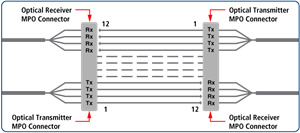5 Best Practices for Certifying Next Generation Networks: Bi-Directional Measurements
02/03/2017
This blog is part three of a series. See article one, article two and article three.
While a single direction loss measurement method is initially quicker and cheaper, a bi-directional method is preferable for more reliable overall network characterization, since it significantly reduces the likelihood of rework and associated costs. Some standards, including ISO/IEC 14763-3, require bi-directional testing to eliminate risk of loss resulting from unknown components.
Historically, the attenuation differences due to test direction were of minor consequence and in line with the accuracy and repeatability of the test method. Therefore, testing in only one direction normally sufficed.
However, with the advent of higher speed systems, tighter loss budgets and bend insensitive fibers, testing in both directions is increasingly required by users to detect mixing of fibers of different core sizes. In addition, field termination and polishing of connectors as well as field splices can potentially result in varying test measurements depending on direction.
One advantage of bi-directional testing is that any mismatches due to difference in fiber type will be accounted for. For example, light travelling from a larger core to a slightly smaller one (or from 62.5 µm to 50 µm) will exhibit more attenuation in one direction than the other. Consequently, it is essential to measure both directions.
As loss budgets tighten, many equipment manufacturers also require bidirectional measurements for purposes of providing a system or cabling infrastructure warranty. Certification Kits that perform bi-directional tests within a single port (i.e. no swapping of fibers required) will not only be more efficient but also yield more consistent results as there is no opportunity for added contamination during dis-connect and re-connect.
Since MPO links/parallel optics utilize a scheme where light is transmitted and received over different fibers within the same connection, it’s critical to test MPO links in both directions to assure performance.

40GbE Base 8 Configuration utilizes 8 fiber channels – 4 in each direction
True bidirectional measurements provide simplified certification eliminating the need for processing and merging unidirectional data into one final result. Further, bidirectional certification provides a level of flexibility for the network operator to reconfigure fibers without worrying about whether testing was completed in a particular direction.
Be sure to perform bi-directional measurements to ensure the highest performance, regardless of network application.
Have any questions? Feel free to contact us.